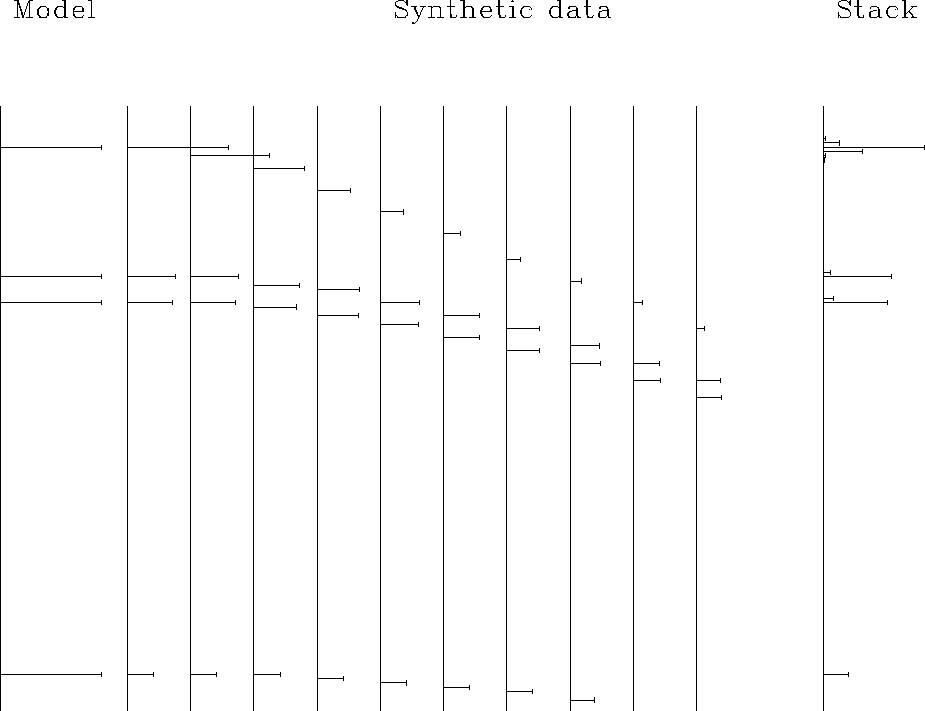![[*]](http://sepwww.stanford.edu/latex2html/cross_ref_motif.gif) .
Recall that the
adjoint of causal integration is anticausal integration.
For each reflector,
data modeling proceeds by throwing out two pulses of opposite polarity.
Then causal summation produces a rectangle between the pulses
(sometimes called ``box car'').
Since the last step in the modeling operator
is causal summation,
the first step in the adjoint operator (which does NMO) is
anticausal summation.
Thus each impulse in the data becomes a rectangle from the impulse to t=0.
Then subtracting values at rectangle ends gives the desired integral of data
in the rectangle.
The code is in subroutines boxmo()
and boxstack().
The traveltime depth
.
Recall that the
adjoint of causal integration is anticausal integration.
For each reflector,
data modeling proceeds by throwing out two pulses of opposite polarity.
Then causal summation produces a rectangle between the pulses
(sometimes called ``box car'').
Since the last step in the modeling operator
is causal summation,
the first step in the adjoint operator (which does NMO) is
anticausal summation.
Thus each impulse in the data becomes a rectangle from the impulse to t=0.
Then subtracting values at rectangle ends gives the desired integral of data
in the rectangle.
The code is in subroutines boxmo()
and boxstack().
The traveltime depth
subroutine boxmo( adj, add, t0,dt, dx, x, nt,slow, antialias, zz, tt )
integer it,iz,itp,adj, add, nt
real t, tp, z, amp, t0,dt, dx, x, slow(nt), antialias, zz(nt), tt(nt)
temporary real ss(nt)
call null( ss,nt); call adjnull( adj, add, zz,nt, tt,nt)
if( adj != 0) call causint( 1, 0, nt, ss, tt)
do iz= 2, nt { z = t0 + dt*(iz-1)
t = sqrt( z**2 + (slow(iz)* abs(x) )**2 ); it = 1.5 + (t -t0)/dt
tp= sqrt( z**2 + (slow(iz)*(abs(x)+abs(dx)))**2 )
tp = t + antialias * (tp - t) + dt; itp= 1.5 + (tp-t0)/dt
amp = sqrt( nt*dt/t) * z/t / (itp - it)
if ( itp < nt ) {
if( adj == 0 ) { ss(it ) = ss(it ) + amp * zz(iz)
ss(itp) = ss(itp) - amp * zz(iz)
}
else { zz(iz) = zz(iz) + amp * ss(it )
zz(iz) = zz(iz) - amp * ss(itp)
}
}
}
if( adj == 0) call causint( 0, add, nt, ss, tt)
return; end
subroutine boxstack( adj,add,slow,antialias, t0,dt,x0,dx,nt,nx, stack, gather)
integer adj, add, ix, nx, nt
real x, slow(nt),antialias, t0,dt,x0,dx, stack(nt), gather(nt,nx)
call adjnull( adj, add, stack, nt, gather, nt*nx)
do ix= 1, nx { x = x0 + dx * (ix-1)
call boxmo( adj,1, t0,dt,dx,x,nt, slow,antialias, stack, gather(1,ix))
}
return; end
